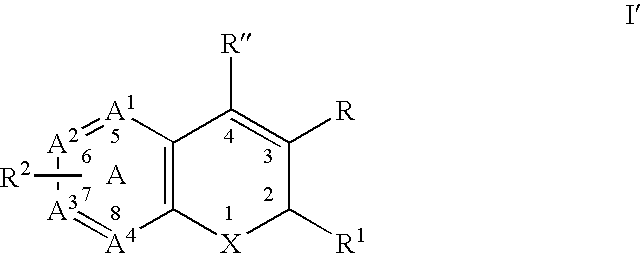Substituted benzopyran derivatives for the treatment of inflammation
a technology of benzopyran and derivatives, applied in the direction of biocide, cardiovascular disorder, drug compositions, etc., can solve the problems of limiting the therapeutic potential and more drastic side effects
- Summary
- Abstract
- Description
- Claims
- Application Information
AI Technical Summary
Problems solved by technology
Method used
Image
Examples
example 1
6-Chloro-2-trifluoromethyl-2H-1-benzopyran-3-carboxylic acid
Step 1. Preparation of ethyl 6-chloro-2-trifluoromethyl-2H-1-benzopyran-3-carboxylate
A mixture of 5-chlorosalicylaldehyde (20.02 g, 0.128 mole) and ethyl 4,4,4-trifluorocrotonate (23.68 g, 0.14 mole) was dissolved in anhydrous DMF, warmed to 60° C. and treated with anhydrous K2CO3 (17.75 g, 0.128 mole). The solution was maintained at 60° C. for 20 hours, cooled to room temperature, and diluted with water. The solution was extracted with ethyl acetate. The combined extracts were washed with brine, dried over anhydrous MgSO4, filtered and concentrated in vacuo to afford 54.32 g of an oil. The oil was dissolved in 250 mL of methanol and 100 mL of water, whereupon a white solid formed that was isolated by filtration, washed with water and dried in vacuo, to afford the ester as a yellow solid (24.31 g, 62%): mp 62-64° C. 1H NMR (CDCl3 / 90 MHz) 7.64 (s, 1H), 7.30-7.21 (m, 2H), 6.96 (d, 1H, J=Hz), 5.70 (q, 1H, J=Hz), 4.30 (q, 2H...
example 2
6-(Methylthio)-2-(trifluoromethyl)-2H-1-benzopyran-3-carboxylic acid
Step 1. Preparation of 5-(methylthio)salicylaldehyde
Ethyl magnesium bromide (38 mL of a 3.0 M solution in diethyl ether, 113.8 mmole) was chilled with an ice-water bath. To the chilled solution was added a solution of 4-(methylthio)phenol (15.95 g, 113.8 mmole) in diethyl ether (30 mL) over 0.15 hour during which time gas was evolved. The reaction was held at 0° C. for 0.5 hour, at room temperature for 0.5 hour, and the addition funnel replaced with a distillation head. Toluene (250 mL) and the diethyl ether were distilled out of the reactor. The reaction was cooled, toluene (250 mL) and hexamethylphosphoramide (HMPA) (19.8 mL, 20.4 g, 113.8 mmole) were added, and the resulting mixture was stirred for 0.25 hours. The distillation head was replaced with a condenser and paraformaldehyde (8.5 g, 284.4 mmole) was added. The reaction was heated to 90° C. for 3 hours. The reaction mixture was cooled to room temperature...
example 3
7-Methyl-2-trifluoromethyl-2H-1-benzopyran-3-carboxylic acid
3-Methylphenol was converted to the title compound by a procedure similar to that described in Example 2: mp 202.1-203.1° C. 1H NMR (CDCl3 / 300 MHz) 7.84 (s, 1H), 7.12 (d, 1H, J=8.3 Hz), 6.82 (m, 2H), 5.65 (q, 1H, J=6.8 Hz), 2.35 (s, 3H). FABLRMS m / z 259 (M+H). FABHRMS m / z 259.0576 (M+H, Calc'd 259.0582). Anal. Calc'd for C12H9F3O3: C, 55.82; H, 3.51. Found: C, 55.93; H, 3.59.
PUM
| Property | Measurement | Unit |
|---|---|---|
| temperature | aaaaa | aaaaa |
| time | aaaaa | aaaaa |
| temperature | aaaaa | aaaaa |
Abstract
Description
Claims
Application Information
 Login to View More
Login to View More - R&D
- Intellectual Property
- Life Sciences
- Materials
- Tech Scout
- Unparalleled Data Quality
- Higher Quality Content
- 60% Fewer Hallucinations
Browse by: Latest US Patents, China's latest patents, Technical Efficacy Thesaurus, Application Domain, Technology Topic, Popular Technical Reports.
© 2025 PatSnap. All rights reserved.Legal|Privacy policy|Modern Slavery Act Transparency Statement|Sitemap|About US| Contact US: help@patsnap.com



